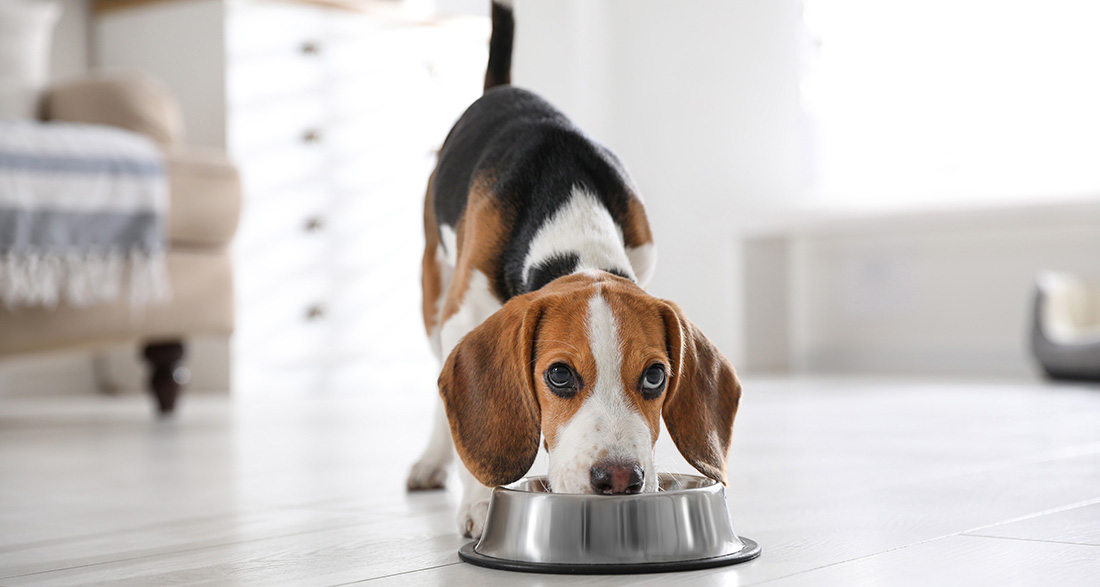Proper nutrition for a dog begins in its puppyhood. For the healthy growth of your puppy, the quality of the food and the appropriate quantity are crucial. The growing dog needs high-quality food that provides sufficient energy and an optimal mix of nutrients. Especially suitable for this purpose is special puppy food, which the young dog receives until approximately one and a half years of age.
- Initially, only Mother’s Milk
- Can I make puppy milk myself?
- From the fourth week: Puppy Food
- Feeding Puppies – How Often: 3 Months, 6 Months, and 12 Months
- Feeding Puppy – The Right Nutrition
- How to Feed Your Puppy According to its Needs
- Wet Food
- BARF (Biologically Appropriate Raw Food)
- What should a puppy never eat?
- No overfeeding
- Large Dog Breeds
Initially, only Mother’s Milk
In the first three weeks of life, puppies consume only mother’s milk, which contains all essential nutrients. Puppies of medium-sized dog breeds should have doubled their birth weight within the first ten days. After six weeks, they should be six to ten times heavier than at birth. To check the weight of the puppies, they should be weighed once a day. If the little rascals do not gain enough weight or even lose weight, the mother may not have enough milk.
In this case, you should consult a veterinarian. The cause often lies in the feeding: The mother dog needs a diet rich in energy and nutrients to produce enough milk.
Occasionally, it happens that female dogs produce too little or no milk, for example, after a cesarean section with spaying or with a very large number of puppies. In such cases, the puppies need to be fed with special puppy milk. This is also necessary if there are very small and weak puppies in a litter that are repeatedly displaced by their siblings and do not get a chance to nurse.
Can I make puppy milk myself?
Raising a puppy by hand with a bottle is a laborious round-the-clock job: Under certain circumstances, it is sometimes necessary.
How often do puppies need to be fed? In the first month of life, the puppy needs to be fed with milk about eight times a day. From the sixth week onwards, you only need to give it a bottle up to six times a day.
However, experts strongly advise against making puppy milk with questionable recipes from the internet. The mother’s milk of the dog, like that of humans, has a complex composition that is very difficult to replicate at home. An unsuitable puppy milk can cause digestive problems such as bloating, constipation, or diarrhea, worsening an already challenging situation.
At the veterinarian or in specialty stores, there is specialized puppy milk that contains all essential nutrients and is generally well-tolerated by puppies.
The milk is fed using a baby bottle with a classic nipple. Under no circumstances should you use a syringe for feeding, as puppies can choke and suffocate.
From the fourth week: Puppy Food
After the first month of life, in addition to mother’s milk, some puppy food or high-quality puppy porridge can be introduced so that the little dogs can meet their ever-increasing need for nutrients. In the eighth to tenth week, the puppies are weaned from mother’s milk. From now on, only puppy food goes into the bowl.
Responsible breeders place their young dogs only after weaning from mother’s milk and provide the new owners with a substantial portion of the familiar puppy food for the transition period.
Feeding Puppies – How Often: 3 Months, 6 Months, and 12 Months
Puppies eat multiple times a day, and the frequency of feeding depends on the age of the young dogs:
- In the first six months, it is advisable to feed the puppy up to four times a day.
- After the sixth month, you can then distribute the daily food ration into two to three portions.
- By one year, small and medium-sized dogs are typically fully grown, and usually, one meal a day is sufficient. Of course, they can still be fed twice a day if preferred. On the other hand, large dog breeds only reach their final stature after one and a half to two years. For these breeds, you should continue to provide two meals a day and maintain this rhythm throughout the dog’s adult life. This helps prevent the potential risk of gastric overload or torsion.
When bringing a puppy home from a breeder or shelter, inquire about the previous feeding times: Veterinarians recommend maintaining these at least during the first few weeks in the new home. After every meal, whether for a puppy or an adult dog, the animals should take a short nap.
Under no circumstances should an extensive walk or a wild play session be scheduled immediately after eating, as too much activity right after eating can lead to a life-threatening gastric torsion for the dog.
Feeding Puppy – The Right Nutrition
The larger the dog breed, the longer the growth phase. But whether large or small: During this time, a puppy needs sufficient energy and the right nutrients to become a healthy adult dog. This requires tailored nutrition.
Weigh Puppy Food Portions Accurately
Measure the food portion for your puppy for an entire day and distribute the rations across individual meals. A puppy should never eat as much and as often as it wants. The amount of food always depends on the specific type of food: Follow the manufacturer’s instructions and guidelines on the packaging. You typically find a table with feeding recommendations for puppies. Pay attention to your dog’s ideal weight for the calculation – it can often be below the current actual weight.
How to Feed Your Puppy According to its Needs
The larger the dog, the longer its growth phase. But regardless of size: During growth, a puppy needs sufficient energy and the right nutrients to develop into a healthy adult dog.
Puppies should receive specialized puppy food. You have the option to choose from the following types of food:
Dry Food
Dry food (like any complete dog food) consists of primary protein sources, carbohydrate sources, and additional nutrients such as minerals and vitamins. The protein sources are usually of animal origin, but there are also plant-based protein sources. The primary sources of carbohydrates are grains such as corn, millet, and rice, as well as potatoes, tapioca, and more.
It has the following advantages:
- Easy dosage
- Good shelf life
- Odor-neutral
- Easy storage
- Low waste
- Promotes dental abrasion and chewing activity in puppies
If you feed dry food, be particularly mindful that your dog’s water bowl is always accessible and well-filled.
Wet Food
While many dog owners assume that wet food contains more meat due to its appearance, this is not the case in most instances. In addition to organ meats and muscle meat, wet food, like any other complete dog food, also contains carbohydrates such as corn, rice, or wheat, along with additional vitamins and minerals.
Advantages of wet food include:
- High acceptance by dogs, as it is more aromatic and flavorful.
- High water content.
- Easy chewing, suitable for older dogs.
- Easier hiding of medications.
Of course, you can offer both feeding methods to your dog.
Tip: In the first two weeks after bringing a puppy home, you should provide the same food that your whirlwind received from the breeder. This helps avoid digestive issues during the initial weeks of a diet change.
BARF (Biologically Appropriate Raw Food)
For those interested, you can also prepare your pet’s daily portion yourself. For a biologically appropriate raw diet, you can either purchase individual components (frozen meat and vegetables + oils and mineral powder) or ready-made BARF menus.
If you want to feed a puppy a raw diet, it is ESSENTIAL to plan the portions with a veterinary nutritionist. Substantial expertise is crucial here, as the nutritional needs must be ideally met and continuously change in a growing animal.
What should a puppy never eat?
In general, you should give your puppy as little outside of meal times as possible. Except for a small ration of reward treats, puppy snacks should remain an exception in the first few months of life. Your dog should not receive anything from the table: Puppies have sensitive stomachs and can quickly develop digestive problems. Some foods are even dangerous for both small and adult dogs. These include:
All these foods contain substances that can be life-threatening for dogs.
No overfeeding
Puppies take about a year to fully grow, and larger dogs take even longer. Most dogs have reached half of their final weight by four months and maintain this growth rate for at least the first year. Large breeds only ease off the growth pedal after about 18 months. A Great Dane reaches its final weight at the age of two years – and it needs that time.
During the growth phase, young dogs need energy, minerals, and protein. However, too much food can be harmful: An excess of energy from food accelerates the growth process and impairs the development of bones, ligaments, tendons, and joints. These structures are overloaded by the strong and rapid weight gain.
This can lead to diseases and postural damage. Well-intentioned addition of vitamins and supplements is also unnecessary and even harmful if you feed high-quality puppy food. For example, calcium is important for bone structure, but it is already present in sufficient quantities in good puppy or junior dog food. Typically, complete puppy food contains everything your dog needs during the growth phase. Keep this in mind with treats as well.

Large Dog Breeds
Owners of large breeds often directly provide adult food to their puppies because they fear that the high energy content of puppy food could overly accelerate the growth of a large puppy. However, by doing so, owners deprive their dogs of important other components of puppy food that are reduced in adult food. Ideally, large breeds should be fed a special large breed puppy food until the age of about one and a half years (very large dog breeds even up to two years).
Feeding Puppies – Key Points at a Glance:
- Puppies are weaned from mother’s milk after the eighth week.
- They are then given special puppy food several times a day. The frequency of feeding depends on their age.
- High-quality puppy food, whether wet or dry, contains all the nutrients a growing dog needs.
- Puppies should not be overfed to avoid rapid growth.
- Certain foods are toxic to puppies, as well as adult dogs.


